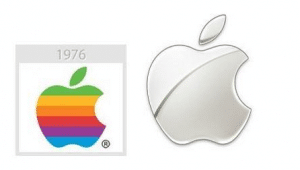Time to rethink your logo? Well, first of all, your company’s logo is meant to be a representation of who you are and what you do. A well-designed logo can last for decades, and you may become quite attached to your business logo over time.
But what happens if your logo ceases to be effective? It isn’t uncommon for companies to hang on to logos that are long past their expiration date.
In fact, big brands often tweak their logos repeatedly, updating them slightly to make them more effective – and more reflective of the company and the times.
One example is the Apple Logo. The original was quite reflective of the era in which it was created. The bright rainbow colors worked. However, tastes have changed. Today’s logo is far more modern than the original, yet still similar in many ways.

How do you know when it’s time for a new logo? That’s what this article will explore.
How Logo Usage Has Changed over Time
Let’s start by talking about how logo usage has changed over time. In the early days of advertising, company logos appeared primarily on product packaging and in print ads.
Companies had a significant amount of control over how logos were used. They could place them where they wanted in print ads, for example, and even decide how prominently to feature them.
As tastes and advertising options evolved, so did logos. In the late Fifties and early Sixties, television commercials began to supplant print ads as the favored advertising method of big brands. Logos became less important as the storytelling aspects of television changed marketing.
Companies have had to adapt their logos to changing circumstances, including pop culture evolution and other influences.
Understanding the Difference between Classic and Dated
One thing you should consider as you evaluate your logo’s effectiveness is the difference between classic and dated. For something to be considered classic, it needs to hearken back to an earlier time without feeling stuck in it.
To understand the difference, it may help to think about a well-known pop culture example. The film Jaws is a cinematic classic and the first true summer blockbuster. But what makes it a classic – and are there elements of the film that don’t stand the test of time?
A look at the movie reveals that the story is very classic. In fact, it’s an update of Moby Dick with a few important twists. It’s a timeless tale of Man vs. Beast and it stands the test of time very well.
What doesn’t hold up are the film’s costumes. To the modern eye, they look seriously dated and even ugly. Some films manage to age without costumes looking dated, but Jaws is an example of the reverse.
Modern Uses of Logos and How They Affect Design
The way logos are used today differs from the past in some significant ways.
Perhaps the biggest change is the prominence of the internet as a tool for marketing and advertising. While some companies still pay for print ads, and many pay for television ads, there are very few business who don’t have an internet presence of some kind.
Logo use online has fundamentally changed logo design. On social media sites, many companies use their logos as profile pictures. The appearance of logos as tiny thumbnails next to Facebook posts and Tweets has necessitated a general simplification of logos so that they are recognizable at all times.
The Starbucks logo is another example of modernization. The original logo was far busier than the current iteration.

The company changed it for more than one reason, but it’s easy to see that the latest version is sleeker, more modern, and far more internet friendly than the old one was.
Evaluating and Rethinking Your Logo
Now let’s talk about how to evaluate your current logo so you can decide whether it’s time for an update. Here are the things you should consider.
- 1. Are the logo’s colors and fonts dated? Many logos today use Sans Serif fonts, which have a clean and modern look. If your font is old-fashioned, you need to ask whether it still works in the modern world. For some companies, and old-fashioned font might be right. Think about newspapers like the New York Times as an example. For others, an update might be in order. The same rule goes for colors. Apple’s early rainbow is an example.
- 2. Is your logo simple enough to look good as a thumbnail? If it’s not, then you may want to simplify it and pare it down so that it does. Sometimes even small changes such as eliminating borders and extra lines can make a big difference.
- 3. How versatile is your logo? Modern businesses need to use their logos in a variety of ways. Depending on your needs, you may use your logo on business cards, product packages, company vehicles, social media sites, print ads, television ads, and even billboards. The logo you choose has to look good no matter what size it is – or where it’s used.
- 4. How marketable is your logo? The question of marketability is a complex one because it must take many things into consideration. Is the logo an accurate representation of your brand? One of the reasons that Starbucks updated their logo is that they wanted to remove the word coffee from it. They intended to expand their brand and didn’t want that word to hold them back.
The takeaway here is that if there is anything about your logo that fails to represent you company as it is today, it needs to be removed or updated. A logo that doesn’t reflect your company’s goals, audience, brand personality, or marketing needs is not an effective logo.
Why Your Feelings about Your Logo Matter
There is one more thing to consider regarding your logo, and it might surprise you.
Take a step back, look at your logo, and ask yourself how you feel about it. It’s a simple question, but an important one.
Remember, your logo is meant to be a visual representation of your brand – and you should feel good about your brand. If you don’t, it is time to make a change.
Branding and Emotion
The reason that emotion matters when it comes to logo design is that branding and emotions go hand in hand. Consumers are known to attach emotions and human characteristics to the brands they love.
For example, the Nike brand evokes action, inspiration, and commitment. Their logo, the world-famous swoosh, and their slogan work together to consolidate that image. The logo itself has a kinetic quality that speaks directly to the brand’s reputation and mission.
When you consider the emotions evoked by your brand, you should think about your feelings as well as those of your customers. How do you feel when you look at your logo? How do you want to feel?
Ask the same questions about your target audience. Why do they buy your products or use your services? What benefits are you providing? Your logo should do a good job of eliciting emotions that reflect what your audience thinks about you.
How to Use Your Emotions to Rethink Your Logo
It’s one thing to recognize that your logo invokes an emotional response, and another to know what to do about that. Here are some suggestions to use your emotions to rethink your logo.
Start by doing some free associations related to different aspects of your logo. Look at the colors and write down whatever comes to mind. Does the red you used make you think of a fire engine? A clown? A cherry? Next, do the same for the font. What does it make you think and feel? If it’s reminiscent of a disco compilation album, it may be time for an logo update.

Next, look at the shapes of your logo. You should look at the overall shape as well as any internal shapes. Circles tend to connote warmth, inclusion, and safety. Rectangles and squares are somewhat cold and analytical, but also solid and reliable. Triangles are exciting and passionate.
In addition to the overall shapes in your logo, there may be other images included. Since artistic styles change over time, you should look at the imagery in your logo and ask if it feels modern and relevant. If you don’t feel good about it, you should consider changing or removing it.
Finally, think about your company’s mission and goals. Do you feel confident that your current logo is an accurate representation of who you are now and what you want to accomplish in the future?
Every element of your logo – the colors, fonts, shapes, images, and overall feel of it – should speak directly to your company at this moment in time. If you have any hesitation or negative feelings about your logo, it is probably time to contact a designer and get it updated.
Conclusion
Your company’s logo can be rooted in the past, but it must speak to both the present and the future to be effective. A careful evaluation of your logo as it relates to your brand’s personality and to your company goals can help you determine if it’s time for an update.
If you’d like to give The Logo Company a chance to rethink your logo.
